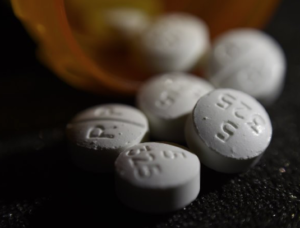
Prescriptions for opioid painkillers have been falling in recent years. At the same time, prescriptions for medications to treat opioid addiction are rising sharply. Credit Patrick Sison/Associated Press
The number of new monthly prescriptions for medications that treat opioid addiction nearly doubled over the past two years, according to new data, while prescriptions for opioid painkillers continued to decline.
The changing calculus reflects a stepping up of efforts among policymakers and the medical establishment to address the nation’s opioid epidemic, which is killing more than 115 people every day. But it also underscores questions about whether some pain patients are now being undertreated, and whether tightened prescribing over the last few years has contributed to the surge in overdose deaths from heroin and especially fentanyl.
Although the number of people taking medications to combat addiction is rising, it remains a small fraction of the roughly 2.6 million people believed to suffer from “opioid use disorder,” or addiction. The federal government has estimated that about 20 percent of them are getting some kind of treatment, but of those, only about a third are getting buprenorphine, naltrexone or methadone, the three medications approved by the Food and Drug Administration.
Prescriptions for opioid painkillers have been dropping since 2011, but the trend accelerated last year with a decline of 10 percent from January through December, according to the IQVIA Institute for Human Data Science, which studies prescription drug use and spending. The highest-dose prescriptions, equivalent to 90 milligrams or more of morphine daily, dropped even more sharply, by 16 percent. Over the course of 2016, high-dose prescriptions dropped by 14.3 percent and opioid prescriptions over all dropped by 1.5 percent.
The number of people newly prescribed opioid pain medicine declined by 7.8 percent over the course of 2017, according to the report, after rising by less than 1 percent the previous year.
The declines come amid a flurry of new insurance company policies and state laws setting limits on opioid prescribing. States have also been tracking opioid prescriptions more closely through electronic databases and requiring more doctors to check the databases for signs of “doctor shopping” or misuse before giving a patient opioids. In New Jersey, the former governor Chris Christie said this year that a new law limiting initial opioid prescriptions there to a five-day supply had led to a 15 percent decrease in overall opioid prescriptions.
Two years ago, the Centers for Disease Control and Prevention released the first national guidelines for prescribing opioids, recommending that doctors try pain relievers like ibuprofen first and that they give most patients only a few days’ supply of opioids. Another important development that has helped propel the decline came in 2014, when the federal government tightened prescribing rules for one of the most popular painkillers: hydrocodone combined with a second analgesic, like acetaminophen.
“I think the message is we are seeing measurable impact from all that’s going on,” said Murray Aitken, executive director of the IQVIA Institute, which published the data as part of a broader report on drug use and spending last year. “These numbers don’t tell you what exactly is driving the acceleration in the drop, but we think it’s useful to get the 2017 numbers out there so people can see what’s happening.”
According to the report, prescription opioid volumes peaked in 2011 at the equivalent of 240 billion milligrams of morphine, declining by 29 percent to 171 billion in 2017. Still, that was enough for every American adult to have 52 pills — “a fivefold higher level than in 1992,” Mr. Aitken said.
Amid a push by the Trump administration and many states to expand access to medications that help treat addiction by curbing cravings and withdrawal symptoms, the report also found that the number of people newly prescribed these medications, including buprenorphine and naltrexone, nearly doubled over the course of 2017, to 82,000 per month from 42,000.
But Dr. G. Caleb Alexander, co-director of the Johns Hopkins Center for Drug Safety and Effectiveness, cautioned that there was no way of knowing from the data whether the prescriptions came with behavioral therapy and other support, as most experts recommend for people taking addiction medication.
“The issue here is there are startling gaps in quality of care for people receiving medication-assisted treatment,” he said. “So it’s really important that we do a better job of improving it and building out systems of care that can deliver it en masse.”
Written by Abby Goodnough and published by The New York Times ~ April 19, 2018.

To sell their drugs, pharmaceutical companies hire former cheerleaders and ex- models to wine and dine doctors, exaggerate the drug’s …
FAIR USE NOTICE: This site contains copyrighted material the use of which has not always been specifically authorized by the copyright owner. We are making such material available in our efforts to advance understanding of environmental, political, human rights, economic, democracy, scientific, and social justice issues, etc. We believe this constitutes a ‘fair use’ of any such copyrighted material as provided for in section 107 of the US Copyright Law. In accordance with Title 17 U. S. C. Section 107, the material on this site is distributed without profit to those who have expressed a prior interest in receiving the included information for research and educational purposes. For more information go to: http://www.law.cornell.edu/uscode/17/107.shtml“
